Photo: Waller Street Victorian - San Francisco, CA
Blue Ox Provided: Moldings, Corbels, Doors, Spandrels, Gingerbread
The beauty of most Victorian houses is in the details and few Victorian details are as recognizable as the corbel. Whether decorative or structural, supporting a mantle or just supporting your design scheme, Blue Ox Millworks is ready to help. Interior, exterior, wood, or plaster, our expert craftsmen are willing to build whatever you need with a gentle touch, a patient chisel, and whatever wood you specify.
Tastefully placed throughout Victorian architecture, corbels are used as decorative brackets or braces, usually for supporting (or appearing to support) an arch, beam or shelf. They can be used anywhere a bracket can be used. Corbels can be plain or hand-carved with an enormous amount of detail. Sizes can vary considerably, often pertaining to their particular use.
(Far Right): Alfonso works on corbels for the Clarkston Community Center (Near Right):Blue Ox wooden corbels adorn the rooftops of a home at G Street in Eureka.
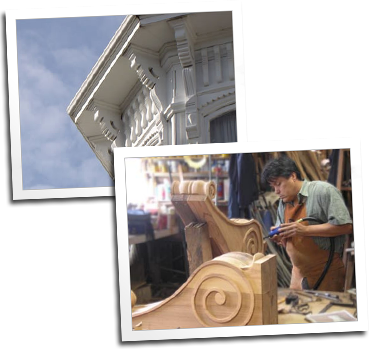
Because of their extra thickness, they are often used in applications requiring strength, such as in supporting a mantel shelf. They may also be placed in the corners of an entrance opening or at the tops of windows to create a distinguished, elegant look.
Inside the home, they may be placed in the corners of cased door openings to add a subtle touch of charm. The placement of ornaments served structural purposes. Corbels, pinnacles topped with finials, flying buttresses, key stones and boss stones in arches, all provided extra weight at critical points to balance the structure against earth and wind movement.
Whether you are looking to completely renovate an entire building, or just looking for an extra-special touch to finish off a room, mantle, or shelf unit, the master craftsmen at Blue Ox are more than happy to help.
(Far Left): Blue Ox collaborated with wood-carver Nate Stipek to construct these maple hand-carved interior corbels and custom scrollwork for a fireplace and mantle assembly. (Near Left): Cesar poses with two custom corbels for a job on Portero Hill, San Francisco.
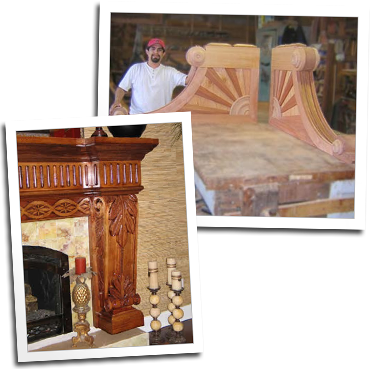
"The word Corbel derives its name from the Latin Corvus, meaning crow. This can probably be attributed to the corbel’s distinctive shape, which is often narrow at the bottom and expands to form a beak at the top. The first corbels were actually the decorative ends of wooden roof support beams.
"Like most elements of architecture, the corbel was born out of necessity. Picture the four walls of a building. Once erected, you need to put a roof on the structure. The easiest way to do that is to lay heavy timbers spanning the top of the walls and construct a gable roof off of these timbers.
"It’s easy to give the sloping walls of the roof an overhang but how could early architects give the gable an overhang to shed water? The answer was to extend the beams beyond the plane of the wall and build the gable off of this new plane, giving an overhang for water to drip from, rather than letting it run down the walls.
(Right Top): Two custom Blue Ox wood corbels stand watch on the deck of the historic Ships Inn. (Right Bottom): Original corbel design for a new Victorian in Ferndale, California
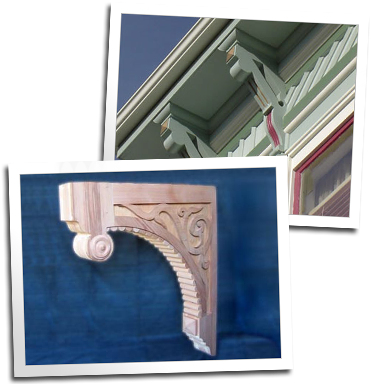
"These exposed beam ends posed their own water problem until craftsmen thought to put a decorative end on them. Water could drip off, and they were pleasing to the eye. Thus, the corbel was born.
"The most common design of these early corbels was the Roman Ogee. This shape provides a graceful transition from the vertical to the horizontal plane. It was soon discovered (probably by the Greeks) that corbels did not need to be structural but also had a visually pleasing function.
"This was fairly unimportant for the Doric order, whose changes were gradual and could be transitioned with moldings, but was extremely useful for the more radical transitions in the Ionic and Corinthian orders. This visual element is how most corbels are used today.
(Far Left): Ten corbels, specially manufactured to be part of a gable for a project in Chicago, Illinois. (Near Left): Custom corbels for the Bell Cottage, one of the world renowned Carter House Inns.
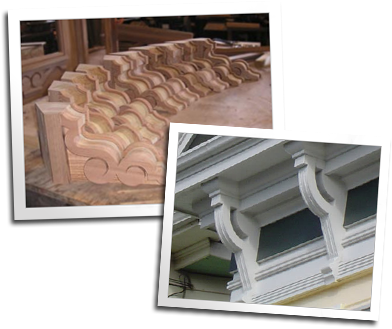
"With the advent of the Victorian era, corbels really began to come into their own. Designers and craftsmen tried an almost infinite number of shapes and decorative add-ons.
"Most of these styles were very pleasing to the eye and fit wonderfully into the design of the house. Occasionally, however, a designer ran into trouble by deviating too far from the golden proportions and the result was often mud-fence-ugly.
(Far Right): In the Blue Ox plaster shop, photo by Alan Griffiths. (Near Right): An unfinished wooden corbel for a house on Waller Street in San Francisco.
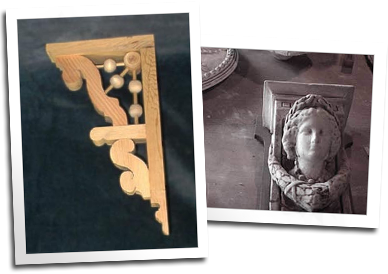
The Golden Proportion...
"So what is this golden proportion? You might say that it was the original Grecian formula! The mathematically-minded ancient Greeks decreed that everything in nature could be described in proportions of 1 to 1.6. The proportions of a tree are 1.6 tall to 1 wide. Your outstretched arms are 1 to your 1.6 in height.
"These proportions are pleasing to the eye because we grow up with them. We see them everywhere, including many of the most visually pleasing corbel designs. Have your corbel go 1.6 tall and come out from the wall 1 or for large overhangs have it go out 1.6 and down 1. You’ll never go wrong."
(Far Left):Another Ship's Inn corbel, one of several Blue Ox projects features in recent editions of Victorian Homes Magazine. (Near Left):Three unpainted Blue Ox exterior corbels with fluting and rosettes.
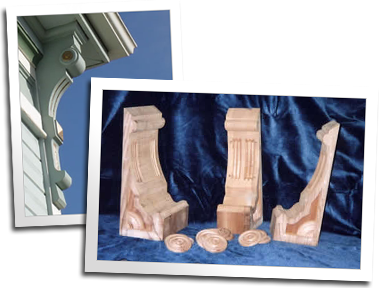
“Beauty in our lives is like a winter coat, it’s not necessary but it sure makes the north wind a lot easier to bear” - Eric Hollenbeck, 1996
(Far Right):The renovation of the commercial building at 2nd and D Street in Eureka called for a lot of custom corbels. (Near Right) Custom wood entrance corbels with polymer clay leaf motif for a home in Piedmont, CA. To learn more about this project click here.
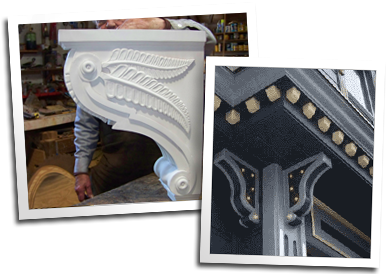
The Golden Proportion...
"So what is this golden proportion? You might say that it was the original Grecian formula! The mathematically-minded ancient Greeks decreed that everything in nature could be described in proportions of 1 to 1.6. The proportions of a tree are 1.6 tall to 1 wide. Your outstretched arms are 1 to your 1.6 in height.
"These proportions are pleasing to the eye because we grow up with them. We see them everywhere, including many of the most visually pleasing corbel designs. Have your corbel go 1.6 tall and come out from the wall 1 or for large overhangs have it go out 1.6 and down 1. You’ll never go wrong."
(Far Left):Another Ship's Inn corbel, one of several Blue Ox projects features in recent editions of Victorian Homes Magazine. (Near Left):Three unpainted Blue Ox exterior corbels with fluting and rosettes.
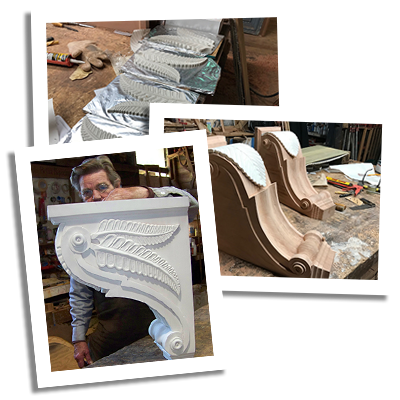
While the information on this website is believed to be true and accurate at the date of publication, neither the authors, webmaster, nor Blue Ox Millworks can accept any legal responsibility for any errors or omissions that may have been made. Prices listed on website are subject to change. © . Blue Ox Millworks. All Rights Reserved. Web Design by DHD